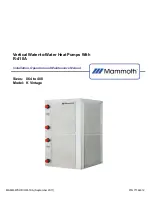
15
MAMM-WSHP-IOM-1KA (September 2011)
Troubleshooting
R-410A
The In’s and Out’s of R-410A
R-410A is a non-ozone depleting blend of two
Refrigerants — HFC-125 and HFC-32 in a fifty percent
mixture. Refrigerant 410A exhibits higher operating
pressure and refrigeration capacity than R-22.
Although R-410A is non-flammable at ambient tem-
perature and atmosphere pressure, it can become
combustible under pressure when mixed with air.
(NOTE: R-410A should not be mixed with air under
pressure for leak testing. Pressure mixtures of dry nitro-
gen and R-410A can be used for leak testing.)
Lubrication
R410A should be used only with polyolester (POE) oil.
The HFC refrigerant components in R-410A will not be
compatible with mineral oil or alkylbenzene lubricants.
R-410A systems will be charged with the OEM recom-
mended lubricant, ready for use with R-410A.
Charging
Due to the zeotropic nature of R-410A, it should be
charged as a liquid. In situations where vapor is nor-
mally charged into a system, a valve should be in-
stalled in the charging line to flash the liquid to vapor
while charging.
All Mammoth K-Vintage units are designed
for commercial use. Units are designed for the
cooling mode of operation and fail safe to heating.
.
Troubleshooting Refrigeration Circuit
Symptom
Head
Pressure
Suction
Pressure
Compressor
Amp Draw
Super
Heat
Subcooling
Water
(Loops)
Temp
Differential
Safety
Lock
Out
Charge
Undercharge
System
(Possible Leak)
Low Low
Low High
Low
Low
Low
Pressure
Overcharge Sys-
tem
Pressure
High High
High
Normal
Low
Normal
High
Pressure
Low Water Flow
Heating
Low
Normal
Low
Normal
Low Low
High
High
Low
Temp
Low Water Flow
Cooling
High High
High High
Low
High
High
Pressure
High Water Flow
Heating
Normal Low Low Low
Normal
Low
High
Pressure
High Water Flow
Cooling
Low Low
Low Low
HIgh
Low
Low
Temp
TXV Restricted
High
Low
Normal
Low
High High
Low
WARNING!
It is very important to make certain that the recycle or
recovery equipment used is designed for R-410A. The
pressure of R-410A refrigerant is approximately 60
percent greater than that of R-22. Pressure gauges
require a range up to 800 PSIG high side and 250
PSIG low side. Recovery cylinders require a 400 PSIG
rating.






































